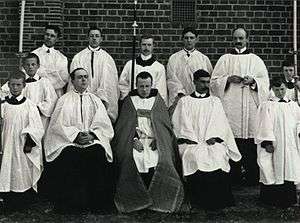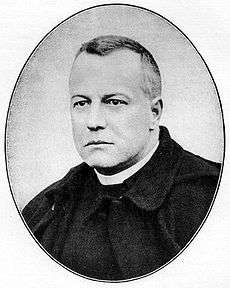Adrian Fortescue
| The Rev. Adrian Fortescue | |
|---|---|
|
A portrait of Father Fortescue from Adrian Fortescue: A Memoir (1924) | |
| Church | Roman Catholic Church |
| Orders | |
| Ordination |
27 March 1898 by Bishop Simon Aichner |
| Personal details | |
| Born |
14 January 1874 Hampstead, London, England, United Kingdom |
| Died |
11 February 1923 (aged 49) Letchworth, Hertfordshire, England, United Kingdom |
| Education |
Scots' College University of Innsbruck |
Adrian Henry Timothy Knottesford Fortescue[1] (14 January 1874 – 11 February 1923) was an English Roman Catholic priest who was an influential liturgist, artist, calligrapher, composer, polyglot, amateur photographer, Byzantine scholar, and adventurer.
Biography
Early life and education
Adrian Fortescue, a direct descendant of the Blessed Adrian Fortescue (d. 1539), was born on 14 January 1874 in Hampstead,[2] London, into a Midland county family of ancient lineage and high position.[3][4] His father was Rev. Edward Fortescue, a renowned High Church Anglican clergyman who was "highly regarded as a preacher and retreat master"[4] and an active participant in the Anglo-Catholic Oxford Movement,[3] before he converted to Catholicism. His mother, Gertrude Martha Robins,[2][5] was the daughter of Rev. Sanderson Robins, another Anglican clergyman, and Caroline Gertrude Foster-Barham,[6] the scion of the Foster-Barham family of Jamaican plantantion owners and granddaughter of the 8th Earl of Thanet.[7]
In 1891 Adrian entered the Scots' College in Rome where, due to his exceptional musical talent, he was soon appointed organist. He was awarded the degree of Bachelor of Divinity in 1892, and his PhD in 1894, when he entered the Theological Faculty at Innsbruck University. He was ordained to the priesthood on 27 March 1898 by Simon Aichner, Bishop of Brixen.[4]
Between 1899 and 1905 he passed doctoral examinations in Moral Theology, Dogma, Ecclesiastical History, Canon Law, Arabic, and Biblical Science—passing the examination in Semitic languages with great distinction, a rare achievement. On 10 June 1905 he was awarded the degree of Doctor of Divinity, making him the very rare recipient of a triple doctorate. The level of his scholarship was so exceptional that he was awarded a prize presented to him personally by the Emperor Franz Joseph I of Austria.[4]
He was also a well-known adventurer, traveling to the Middle East, Asia Minor and Greece, among other places. In the process, he learned Syrian Arabic, some Turkish, and Persian (he was already fluent in Greek from his academic studies).[4]
At the time of his death, Fortescue was Professor of Church History at St. Edmund's College, Ware, the oldest Catholic school in England.[4]
Ministry

After a number of temporary positions, interrupted by his doctoral examinations, Fortescue was eventually appointed Missionary Rector of Letchworth in Hertfordshire in November 1907. There he faced the task of building a church from scratch. Much of the church he designed and paid for personally, and parish records show that he in fact donated more each year than he received in his annual stipend. In time the beautiful little church, dedicated to St. Hugh of Lincoln, became renowned for its music and rich liturgical life.[4]
Although Fontescue's personal inclination was for the life of a scholar, his sense of duty would never allow him to put his scholarly pursuits before the care of the souls entrusted to him. He would give the last penny in his pocket to help a needy parishioner, and frequently found himself in financial difficulties as a result of his generosity. He never refused to see a caller, however inconvenient it might be for him to interrupt his work.[4]
Death
On 20 December 1922, Fortescue was diagnosed with cancer. He preached his last sermon on 31 December, a simple but profound lesson on the reality of the Incarnation of Christ, ending with the words, "That is all I have to say." On 3 January 1923 he left Letchworth for Dollis Hill Hospital, where he died of cancer on 11 February. Against the wishes of his family, he was buried at Letchworth, among his own parishioners.[4]
Works
The best-known of Fortescue's publications during his lifetime was Ceremonies of the Roman Rite Described, which he actually wrote not out of academic interest but to raise funds for construction on his church.[4]
In 1913 Fortescue compiled a book of Latin Hymns which he originally gathered for the use of his parishioners, providing his own English prose translations.[4] He also contributed many articles to the Catholic Encyclopedia (1907–1913), and it is in this context that his work has the most public familiarity today.
With his love of history and skill with languages, Fontescue devoted much study to the origin and history of the Eastern Churches, both Catholic and Orthodox. Among his most famous works is The Orthodox Eastern Church and The Lesser Eastern Churches. Adrian Fortescue says that intolerance of all other customs with the wish to make the whole Christian world conform to its own local practices has always been and still is a characteristic note of the Byzantine Church or Eastern Orthodox church.
Fortescue was also an artist of considerable talent, especially in the media of watercolor, drawing and calligraphy. He was also a recognized authority on heraldry, and his own designs were widely admired in his day. A memorial exhibition of Adrian Fortescue's work was organized in the Letchworth Public Library in 1923.
Selected bibliography
- Fortescue, Adrian (1934). Ceremonies of the Roman Rite Described. Burns, Oates & Washbourne ltd; 5th ed edition.
- Fortescue, Adrian (1994). Latin Hymns. reprint: Roman Catholic Books. ISBN 0-912141-13-1.
- Fortescue, Adrian (2000). Orthodox Eastern Church. reprint: Adamant Media Corporation. ISBN 1-4212-4904-9.
- Fortescue, Adrian (2001). Lesser Eastern Churches (The Eastern Churches Trilogy). reprint: Gorgias Press. ISBN 0-9715986-2-2.
Works about Fortescue
In 1999, Michael Davies published The Wisdom of Adrian Fortescue about the life and contributions of Dr. Fortescue.[note 1]
In 2007, Anthony Dragani published a book entitled, Adrian Fortescue and the Eastern Christian Churches, a critical examination of his writings on the subject, analyzing what he said about the Eastern Christian Churches, and highlighting his insights into key questions.[note 2]
Memorials

An exhibition about Father Adrian Fortescue and the Church of St Hugh of Lincoln he founded was produced by the First Garden City Heritage Museum, in Letchworth Garden City. The exhibition featured rare and special objects relating to Fortescue and the church, and ran from 5 November 2007 until 26 January 2008.
The First Garden City Heritage Museum holds material relating to Father Adrian Fortescue, as well as copies of the exhibition text, images and display material.[8]
See also
| Wikisource has original works written by or about: Adrian Fortescue |
Notes and references
- Notes
- References
- ↑ "England & Wales, National Probate Calendar, 1858-1956". Ancestry.com. Retrieved 14 March 2013.
- 1 2 "1881 England Census". Ancestry.com. Retrieved 14 March 2013.
- 1 2 Dragani, Anthony (2007). Adrian Fortescue and the Eastern Christian Churches. Piscataway, N.J.: Gorgias Press. p. 2. ISBN 1-59333-345-5.
- 1 2 3 4 5 6 7 8 9 10 11 Davies, Michael. "Adrian Fortescue: Priest and Scholar". Retrieved 7 July 2010.
- ↑ "FreeBMD Marriage Index". FreeBMD.com. Retrieved 14 March 2013.
- ↑ "1851 England Census". Ancestry.com. Retrieved 14 March 2013.
- ↑ "Barham Family, Welsh Biography Online". Retrieved 14 March 2013.
- ↑ "FGC Heritage Museum". Letchworth Garden City Tourist Information Centre. Retrieved 7 July 2010.
External links
- The Genius of Adrian Fortescue, Priest and Scholar by Madeleine Beard
- The Greek Fathers 1908
- The Mass: A study of the Roman Liturgy 1913
- Donatism 1917
- The Wit of Adrian Fortescue by Fr. Nicholas Schofield
- Images from the diary of Adrian Fortescue
